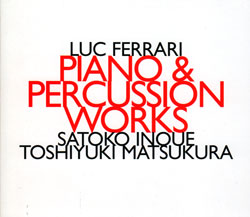
If listeners know Ferrari at all, it's probably his tape work, pieces like Presque Rien, so this set is a welcome addition to his recorded catalog featuring, as it does, largely instrumental music (with a partial exception). The performers are Satoko Inoue (piano) and Toshiyuki Matsukuwa (percussion)
The disc begins with "Conversation Intime" (1987/88), a composition that's almost impossible to describe without using the term, "delightful". Piano and vibraphone (then drums) float around each other languorously, unfurling graceful tendrils, touching, slipping away. Motifs recur, sometimes with a jazzy inflection and rhythm, though they quickly evanesce, possibly to reform later. Remember those early ECM duets between Chick Corea and Gary Burton? Well, if you increased those musicians inherent musicality about threefold, you might get something like this. Um....delightful!
There follow two pieces from the mid-50's, "Visage I" (1956) and the tri-part "Sonatine Elyb pour Piano" (1953/54). They're actually somewhat "old-fashioned" for the time, fashioned in something of a modernist/romantic vein, full of craggy tors and dark, plunging abysses. Solid, if unessential.
But then we come to the centerpiece of the release, "Cellule 75 — Force de rythme et cadence forcée" (1975). Those unfamiliar with this composition might be quite shocked, not only at its pronounced minimalist elements but at the way Ferrari was already, in 1975, turning those elements inside out against themselves, creating a piece that comments on his contemporaries while subsuming them into the Ferrari universe. In fact, it begins with an uninterrupted minute or so of open-air recording before the piano enters gently. At first, Inoue churns out regular, small cells, the percussion (drums) likewise, over the magnetic tape which becomes less intricate, more a rough wash of echoing sound. The music is as insistent as anything by Reich or Glass from the same period but it's also, refreshingly, dirtier, somehow less pristine. This initial portion dissolves, replaced by harpsichord (prerecorded, apparently), a different percussive rhythm and a far more jagged piano. The minimalist kernel is still there but it's being challenged, smudged. Soon, it's up to the tape to maintain even a semblance of rhythm, the two acoustic instruments having fallen into a spiky morass somewhere between Boulez and Cecil Taylor. About halfway through, it's almost become toy music, the piano seemingly making reference to "Diamonds Are a Girl's Best Friend". Just when things feel like they'll fall complete to pieces, however, rigor is restored and a variation of the initial themes is presented. Near chaos once again ensues, though with enough of a rhythmic insistence that matter just keeps from spinning off by sonic centrifugal force. It coalesces into a relentless iteration of those tight kernels, becoming deliciously irritating in its singleness of purpose, insanely marvelous.
Comments and Feedback:
|



